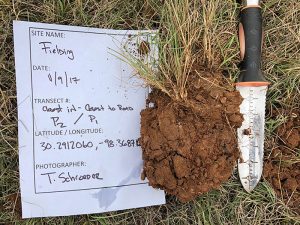In a new video series: Soil Health 101: Principles for Livestock Production, NCAT Sustainable Agriculture Specialist Nina Prater makes the case for modeling soil health strategies after nature’s blueprint that produced that situation in the first place.
We all know the basic story. Plants photosynthesize sunlight and make sugars. They use the sugars to build leaves and stems and roots and seeds – pretty much everything that makes a plant a plant.
But at the same time, they share the wealth by exuding sugars from the roots to feed a “community” of soil microbes and fungi that in turn help keep the soil healthy for the plant.
A classic win-win situation.
“This layer of productive soil on top of the bedrock that we all have to work with is this vibrant living thing that has a community of life within it,” Nina says. “You have to treat it like a living thing because it is.”
And just like any living thing, there are practices that can keep it healthy and practices that can cause it harm.
Nina and other NCAT staffers produced a three-part webinar series – Soil Health 101 – through the ATTRA sustainable agriculture program, along with support from the USDA National Institute of Food and Agriculture (NIFA) and the Southern Sustainable Agriculture Research and Education program (Southern SARE).
You can watch the webinars here:
- Soil Health 101: Principles for Livestock Production
- Soil Health 101: Cover Crops and Water Infiltration
- Soil Health 101: Grazing and Soil Health with Jody Reyer
The series has a particular focus on the role livestock can play in soil health, but its strategies for keeping soil healthy is good information for any producer.
Those strategies are often described as the principles of soil health. Nina breaks it down to five.
- Minimize disturbance to the soil
- Maximize biodiversity on the land
- Keep the soil covered at all times
- Keep living roots growing in the soil during as much of the year as possible
- Incorporate animals and use regenerative grazing practices
Nature provides models for how to put those principles of soil health into place, Nina says, and the webinar is full of practical examples of just that.
“To build soil health on our farm, we have to look to nature to figure out how to do that. Nature built all of these soils in the first place,” she explains. “The planet wasn’t created with all these, you know, lush terrains and prairie and everything. All that evolved over time. And it evolved with these ecosystem that built soil.”
To learn even more about the importance of soil health, and to connect with farmers, ranchers, and land managers taking steps to regenerate their soils, visit SOILFORWATER.ORG.



